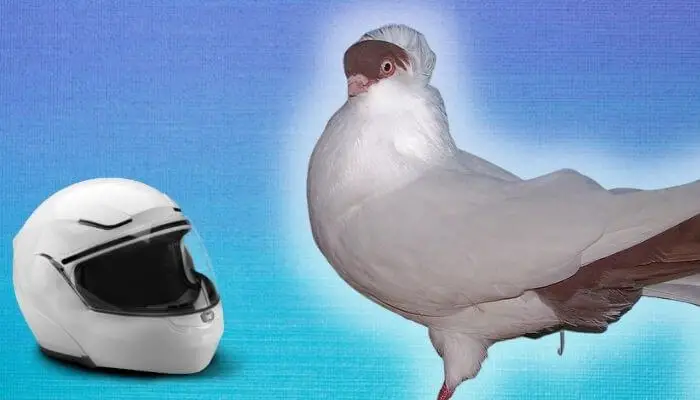The helmet pigeon is a fancy pigeon, the result of many years of selective breeding.
It’s fallen in and out of popularity among pigeon breeders, but the helmet pigeon is a unique breed that many people love.

The helmet pigeon goes by a couple of other names such as the helmet crested pigeon and the German helmet pigeon.
Origins Of The Helmet Pigeon
While the exact origins of the helmet pigeon aren’t known, it has been referenced as far back as the 1500s.
It likely originated in Persia, but it is definitely well-known in the 1700s in Germany.
The breed was refined mostly in the USA when it was imported in the early years of the 20th century although most of the development took place after the 1950s when a small group of breeders gradually expanded to form a national Helmet pigeon club.
East Coast breeders focussed on developing the short-faced Helmet, while the medium-faced was favored by the West Coast (particularly in California where the breeding was mostly begun).
The medium-faced was, until the 1970s, a strong flier and tumbler but the breed has been refined to become mostly a show bird.
As well as the USA, the Helmet pigeon is today popular in Australia and Canada with a small following in the UK and Europe.
Unsurprisingly, the Helmet pigeon has common ancestry with the Nun pigeon.
They are both characterized by their distinctive “headgear” markings – the helmet and the wimple!
Helmet Pigeon Characteristics
A Helmet pigeon has a distinctive look to set it apart from other breeds.
As its name indicates, the bird had a rounded head, absent of any flatness.
This curved appearance mimics the look of wearing a helmet and it is even more pronounced in certain colorways, it is similar to the Nun and Mookee pigeons.
Some Helmet pigeons have a prominent crest, enhancing the head shape and making it appear smooth from front to back.
When it comes to showing this pigeon, great attention is paid to the head detail such as the shell shape of the crest which forms the helmet, eye color which should be pearl-like and the color of the beak which should be like bleached bone.
Helmet pigeons are medium in size, weighing up to 350 grams and reaching lengths of about 17 to 20 centimeters.
They have sturdy red legs with red feet that are smooth in texture and free of feathers (although recently, breeders have been experimenting with the development of foot feathers).
Their tails are usually straight and usually have 12 main feathers that are tightly packed..
The feathers of a helmet pigeon are generally smooth and help create its proportional appearance.
The main body of the pigeon is made up of white feathers, with brown or other colored feathers on the tail.
Their head feathers are the same color as their tail feathers.
Always with a white body, the possible colors for the helmet and tail include black, blue, red, silver and yellow.
In some cases, helmet pigeons have a mixture of colors.
This is usually referred to as “all other recognized colors.”
Helmet Pigeon Behaviour
Helmet pigeons are hardy and have a lovely personality.
They are a perky, intelligent bird and being sociable in nature, they don’t mind being handled.
As well as being fun to show, Helmet pigeons are a great breed for keeping as pets.
Breeding Helmet Pigeons
Modern short-faced Helmet pigeons can be indifferent parents, so breeders are used to having to foster or hand rear their baby pigeons. This trait isn’t as common in medium-faced Helmet pigeons.
As with all pigeons, they should not be overbred – two or three times a year is best.
Diet should be adjusted accordingly to aid in egg production and the production of crop milk.
Breed Variations
The Polish Helmet pigeon is a breed of Helmet pigeon.
Its main differing characteristic to the regular Helmet is the presence of large feathers on its feet. It also features colored feathers on only the top half of its head, as well as its tail.
As the name implies, the Polish helmet pigeon originates in Poland and also goes by the names Polish Krymka Tumbler and Krymka Polska.
It’s a medium-sized bird and is white, save for its head and tail feathers. It also features a small crest on its head.
Like the helmet pigeon, the Polish variation is mainly used as a show or ornamental bird. It also makes a nice pet.
This breed is easy to tame and train and is sociable and easy to take care of.
